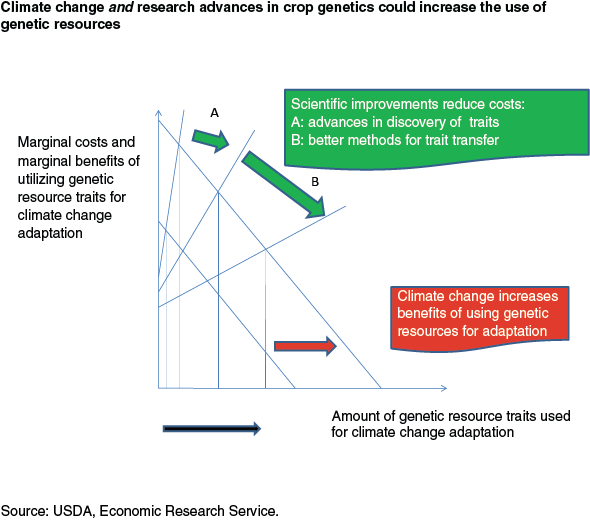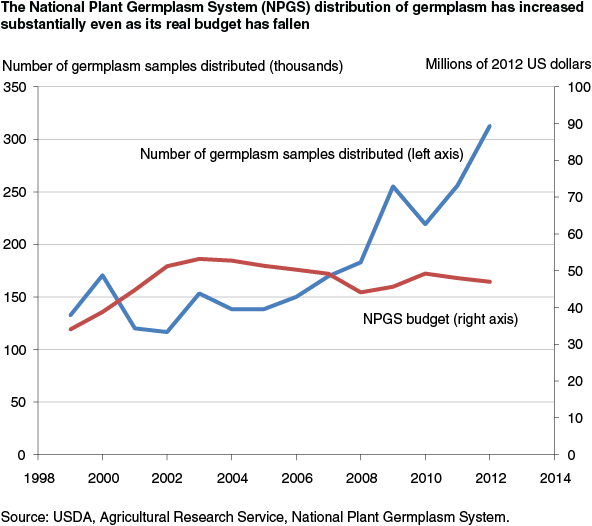Crop Genetic Resources May Play an Increasing Role in Agricultural Adaptation to Climate Change
- by Paul Heisey and Kelly Day Rubenstein
- 6/1/2015
Highlights
- As agriculture adapts to climate change, crop genetic resources can be used to develop new plant varieties that are more tolerant of changing environmental conditions.
- The public sector plays an important role in collecting, conserving, and distributing crop genetic resources because private-sector incentives for crucial parts of these activities are limited. The U.S. National Plant Germplasm System (NPGS) is a key provider of genetic resources; in recent years, demand for crop genetic resources from the NPGS has increased rapidly even as the NPGS budget has fallen in real dollars.
- Institutional factors such as international agreements and intellectual property protection can affect use of crop genetic resources; recently, international access appears to have become more limited.
Climate change poses a significant risk to future crop productivity as temperatures rise, rainfall becomes more unpredictable, and patterns of disease and pest infestation change. The development of crop varieties better adapted to a changing climate will require new varieties with traits that are derived from genetic resources, such as better tolerance to heat, drought, or pests and diseases.
What Are Crop Genetic Resources, and How Are They Conserved?
Crop genetic resources (or germplasm) consist of seeds, plants, or plant parts that can be used in crop breeding, research, or conservation. Crop germplasm falls into several major types. Advanced or “elite” germplasm is created with modern breeding techniques; it consists of genetic material from recently developed varieties, older varieties no longer widely used but still useful for breeding, and other breeding materials. Advanced germplasm has many desirable traits for agricultural production and these are relatively easy to incorporate in new varieties. Landraces are varieties that have been improved by farmers over many generations without modern breeding. Accessing and using landraces for crop improvement purposes is more difficult than using advanced breeding materials, in part because the desirable traits may be genetically linked to traits breeders do not want to use. Crop wild relatives are undomesticated plants that share a common ancestry with a crop species. They are even more difficult to use as a source of valuable traits in commercial varieties because gene transfer from wild relatives by conventional breeding techniques is more difficult. However, these latter types of germplasm may contain valuable, previously undiscovered genetic traits (such as new sources of resistance to heat) not found in advanced materials. The advent of modern biotechnology has allowed for DNA sequences from other organisms to be inserted into crops using molecular techniques. (By themselves, these sequences cannot be used to regenerate an organism.) Also, genetic variants such as mutations can be useful as plant research tools.
Genetic resources can be conserved either in situ (in their natural setting) or ex situ (outside their natural setting). Much of the world’s plant genetic diversity occurs in situ. However, genetic resources, particularly landraces and wild relatives, usually need to be collected from many parts of the world where they grow before they can be used by breeders as source material for improving crop varieties. The most important sources of in situ genetic resources can be found in regions where crops were originally domesticated. Ex situ conservation of some crops can store large amounts of genetic material as seeds at relatively low cost, and tissue samples at slightly higher cost. The world’s genebanks presently hold more than four million distinct samples of crop germplasm. However, only a fraction of the world’s plant genetic resources have been collected.
Climate Change Will Likely Increase the Demand for More Resilient Crops, While Scientific Advances May Reduce the Cost of Identifying and Incorporating Helpful Traits
ERS researchers have identified two sets of factors that may affect genetic resource use. First, if climate change is observed (or even anticipated), the expected benefits from using genetic resources to develop better adapted, more resilient varieties are likely to increase, in turn increasing actual genetic resource use. Second, research advances in crop genetics may reduce the cost of genetic resource use. If scientists can improve the processes for discovering useful crop traits in genetic resources, costs of new genetic resources may fall, and genetic resource use would then expand more. If, in addition to accelerated trait discovery, scientists find new, more efficient methods to transfer complex traits to commercial varieties, costs could fall even more and genetic resource use would increase yet further.
Public investments in genetic resource conservation, evaluation, and basic scientific understanding of genetic resource use are likely to be necessary if the best results for society as a whole are to be achieved
The simple supply-demand framework shown above ignores many of the complexities in the long process that leads from the identification of useful genetic traits to their incorporation in commercial crop varieties. For many parts of this process, incentives for private firms may not be sufficient to stimulate the needed investment in genetic resource conservation, identification, and use. When seeds or other plant propagating material are purchased, the genetic content of these materials is purchased at the same time. As a result, genetic resources are easily transported and replicated, and unless legal limits are present and honored, it is difficult for an individual country, firm, or farmer to exclude others from their use. If a country or firm cannot exclude others from using the genetic information in seeds or other materials for propagating crops, other users have little incentive to pay the seller for developing that information, reducing the motivation to develop crop genetic resources.
Furthermore, the usefulness of particular genetic resources, such as landraces and crop wild relatives, is highly uncertain. Time horizons for improving genetic resources are long. There are few private incentives to conduct “upstream” research, such as adding new samples of germplasm to genebanks, screening germplasm for desired traits, and incorporating genes from unimproved genetic resources into the advanced breeding materials used to create marketable varieties. Thus, a basic economic argument underlying public policy related to genetic resources is that the private sector tends to underinvest in research incorporating these resources, meaning that some public investment is desirable.
The U.S. National Plant Germplasm System (NPGS) is the primary network that manages publicly held crop germplasm in the United States. This multi-institutional network is one of the largest genebank systems in the world. In recent years, demand for crop genetic resources from the NPGS has increased rapidly even as the budget for the NPGS has fallen in real dollars since 2003. By way of comparison, the 2012 NPGS budget of approximately $47 million was well under one-half of 1 percent of the U.S. seed market of over $20 billion in that year.
Institutional factors may act as barriers to genetic enhancement in adaptation to climate change
In addition to natural and scientific factors, institutional factors can also affect the utilization of genetic resources in adaptation to climate change. Like all countries, the United States depends on genetic material that is not incorporated into its own genebanks. Relatively few crop genetic resources originate in the United States.
Twenty-five years ago, germplasm was exchanged in a relatively open system. Now, access to genetic resources may be governed by one or more of several international agreements, in particular the Convention on Biological Diversity (1992) and the International Treaty on Plant Genetic Resources for Food and Agriculture (2004). The United States has signed but not yet ratified the Convention on Biological Diversity and the International Treaty. One implication is that the United States has less say in the international negotiations over implementation of the agreements.
Intellectual property (IP) rights can also affect genetic improvement directly through incentives that both foster innovation and limit access to new discoveries. The World Trade Organization, of which the United States is a member, has moved towards greater international harmonization of IP rights systems through the 1994 Agreement on Trade Related Aspects of Intellectual Property rights (TRIPS), which requires member countries to adopt minimum standards of IP protection. Nonetheless, different countries have maintained different levels of IP protection for crop genetic resources. One result may be that seed companies are less willing to invest in countries with lower levels of protection.
For a number of reasons, which may include both the greater codification of rules for germplasm exchange and for IP (as well as the fact that many large genetic resource collections have already been transferred from genebank to genebank), the number of accessions to the NPGS from non-U.S. sources in a recent 5-year period was only about 8 percent of what it was in a similar period 30 years earlier. In contrast, in the mid-2000s, the NPGS estimated that it distributed approximately six accessions to other countries for every accession it received.
Limited access to particular kinds of materials identified as important by crop germplasm specialists may be an even more reliable indicator of increasing constraints to germplasm acquisition than declining total accession counts. Recently, USDA has faced greater obstacles to collection of germplasm in other countries. Many countries have not allowed USDA access, or the terms required for access are not acceptable for material entering the NPGS, which freely provides materials without IP restrictions. Limitations on access to in situ resources reduce opportunities to collect materials, such as crop wild relatives, that may have traits that are useful in adaptation to climate change. Thus, in addition to general public support for genetic resource collection, conservation, and pre-breeding activities, skilled negotiations may be necessary to overcome institutional constraints to international access to crop genetic resources.
This article is drawn from:
- Heisey, P. & Day Rubenstein, K. (2015). Using Crop Genetic Resources to Help Agriculture Adapt to Climate Change: Economics and Policy. U.S. Department of Agriculture, Economic Research Service. EIB-139.
We’d welcome your feedback!
Would you be willing to answer a few quick questions about your experience?




